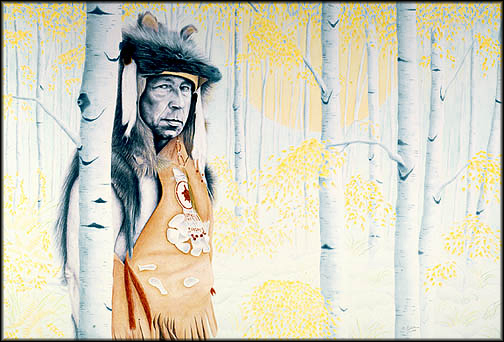This piece is a portrait of Drifting Goose, who became the first elected Grand Sachem (chief) of the Wampanoag in 1975. His nation was once comprised of about fifty tribes spread out throughout southeastern Massachusetts and eastern Rhode Island.
Standing in birch woodland, Drifting Goose wears a wolf skin, the totem of his people. To the Wampanoag, animals represent an aspect of life that is to be emulated. The wolf, an extremely social animal, is respected as a strong symbol of family.
While Drifting Goose was still leader, he held a similar position that King Philip did in his lifetime. Among the first tasks he pursued after being elected was to call for federal recognition of the Wampanoag and he took steps to reclaim both ancestral lands and his people’s fishing and hunting rights.
A traditionalist, Drifting Goose helped restore some time-honored practices among the Wampanoag. “The drum was brought back because it is the heart of Indian people. It’s made from the trunk of our brother the tree and from the skin of our brother the deer. Made in the shape of a circle, it represents the center of life, one of balance and harmony. When the drum beats, it draws us closer to Mother Earth and it moves our soul. We come together at the powwows to practice the traditions that make us whole,” says Drifting Goose.
A long time activist, Drifting Goose established the Boston Indian Council and helped found the Eastern Seaboard Indian Coalition, which later became the Coalition of Eastern Native Americans. For his own nation, he has reestablished two of the Wampanoags’ lost bands, the Assonet and Nemasket, and has brought back the Council of Chiefs.
This portrait acknowledges the contributions Drifting Goose has made in the restructuring and restoration of his tribe and the crucial role he has played in making his people aware of their cultural identity.
